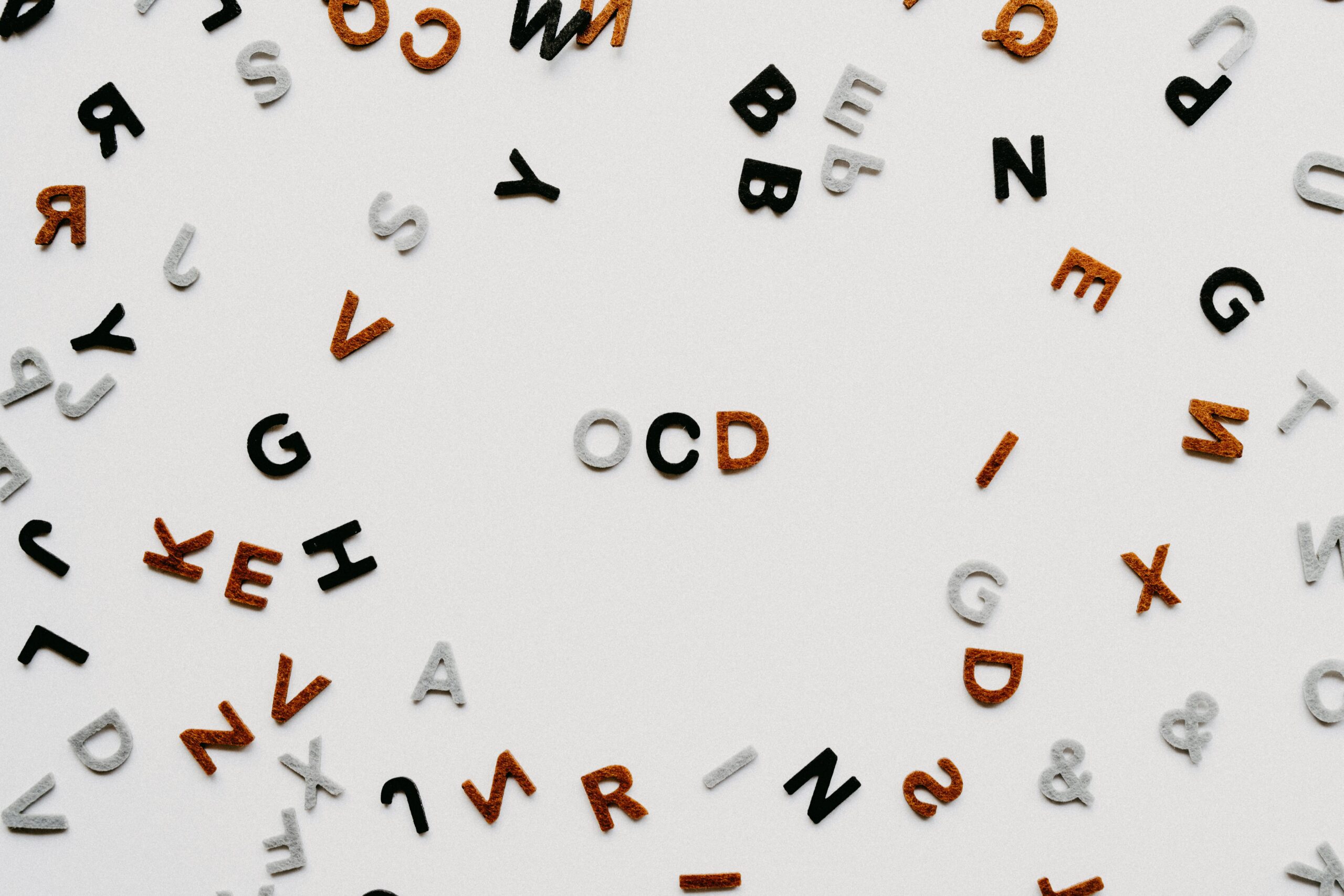What are the 4 Types of OCD
When most people think of Obsessive-Compulsive Disorder (OCD), they picture someone washing their hands repeatedly or checking locks obsessively. But OCD is far more complex and varied than these stereotypes suggest. In fact, OCD can show up in 20 different sub-types! Each sub-type captures a different grouping of symptoms–from counting to contamination, or harmful thoughts to relationship obsessions.
In this blog post, we will explore the four primary types of OCD, and in subsequent posts, we will dive into details around other sub-types that we see at our clinic.
Understanding the different types of OCD can help you recognize whether you or someone you love is struggling with this often-misunderstood condition–it’s more than just being “neat.” In this comprehensive guide, we’ll explore the four main types of OCD, the telltale signs of each, and most importantly, what you can do to find relief and reclaim your life.
Before diving into the specific types, it’s important to understand what OCD actually is. Obsessive-Compulsive Disorder is a mental health condition characterized by two main components:
Obsessions: Intrusive, unwanted thoughts, images, or urges that cause significant anxiety or distress. These aren’t just everyday worries—they’re persistent, disturbing, and feel impossible to control.
Compulsions: Repetitive behaviors or mental acts that a person feels driven to perform in response to an obsession. These are done to reduce anxiety or prevent a feared outcome, even though the relief is only temporary.
The key to OCD is the cycle: an intrusive thought creates anxiety, which drives a compulsive behavior, which provides temporary relief, which reinforces the cycle. Over time, this pattern becomes increasingly rigid and time-consuming, often taking over hours of each day.
Research suggests that OCD affects approximately 2-3% of the population, making it more common than many people realize. It typically begins in adolescence or early adulthood, though it can develop at any age. And while OCD manifests in countless ways, mental health professionals have identified four primary categories that encompass most presentations of the disorder.
4 Types of OCD
Type 1: Contamination and Cleaning
What It Looks Like:
Contamination OCD centers around an intense fear of germs, dirt, illness, bodily fluids, chemicals, or other contaminants. People with this type of OCD experience overwhelming anxiety about being “dirty” or contaminated, which drives them to engage in excessive cleaning or avoidance behaviors.
- Fear of catching diseases from touching surfaces or other people
- Worry about spreading germs to loved ones
- Intrusive thoughts about being contaminated by chemicals, bodily fluids, or “unclean” objects
- Preoccupation with certain textures or substances feeling “wrong” or “dirty”
- Fear of environmental contaminants (asbestos, radiation, pesticides)
Common Compulsions:
- Excessive hand washing (sometimes for hours daily, until skin is raw)
- Showering multiple times per day with specific rituals
- Using excessive amounts of soap, sanitizer, or cleaning products
- Avoiding public places, door handles, or shared spaces
- Creating elaborate rules about what is “clean” vs. “contaminated”
- Requiring family members to follow strict cleaning protocols
- Disposing of items believed to be contaminated
Signs You May Have This Type:
Do you spend more than an hour daily washing or cleaning? Do you avoid certain places because they feel “contaminated”? Have you noticed your hands are dry, cracked, or bleeding from excessive washing? Do you have strict rules about what’s clean and what’s dirty that others find extreme? If you answered yes to any of these, contamination OCD might be affecting your life.
Type 2: Checking and Harm-Related Obsessions
What It Looks Like:
This type of OCD revolves around fears of being responsible for harm—either causing it accidentally or failing to prevent it. People with checking OCD experience relentless doubt about whether they’ve done something dangerous or left something unsafe, driving them to check repeatedly. People with checking OCD can also seek reassurance from their own checking or from others that something is okay.
Common Obsessions:
- Fear of having left doors unlocked, appliances on, or windows open
- Worry about causing a fire, flood, or burglary through negligence
- Intrusive thoughts about accidentally hitting someone while driving
- Fear of having harmed someone without realizing it
- Doubt about whether you’ve made a catastrophic mistake
- Worry about being responsible for something terrible happening
Common Compulsions:
- Checking locks, stoves, or appliances multiple times (sometimes dozens of times)
- Driving back to check if you hit someone or something
- Repeatedly asking others for reassurance that everything is okay
- Taking pictures of appliances or locks as “proof” they’re off/locked
- Retracing steps to ensure no harm was done
- Mentally reviewing actions to confirm nothing dangerous happened
- Creating elaborate checking routines that must be done “perfectly”
Signs You May Have This Type:
Do you return home multiple times to check if you locked the door? Do you spend significant time making sure appliances are turned off? Have you ever driven back to check if you hit something? Do you constantly ask family members, “Did I do something wrong?” or “Is everything okay?” Does the doubt feel impossible to shake, no matter how many times you check?
If these experiences resonate with you, checking OCD may be impacting your daily life and stealing hours from your day.
Type 3: Symmetry and Ordering
What It Looks Like:
Symmetry OCD is characterized by an intense need for things to be “just right,” symmetrical, balanced, or in perfect order. Unlike a preference for neatness, this type of OCD causes severe distress when things feel asymmetrical, uneven, or incomplete.
Common Obsessions:
- Intense discomfort when objects aren’t perfectly aligned or symmetrical
- Feeling like something terrible will happen if things aren’t “just right”
- Preoccupation with numbers (needing to do things in even numbers, multiples, etc.)
- Intrusive feelings that actions must be completed a specific number of times
- Distress about unevenness or imbalance
- Magical thinking that order prevents bad outcomes
Common Compulsions:
- Arranging objects until they feel “perfect”
- Organizing items by color, size, or other rigid categories
- Tapping, touching, or moving in symmetrical patterns (both sides must feel equal)
- Counting to specific numbers or performing actions a set number of times
- Rewriting or rereading until it feels “right”
- Starting tasks over if interrupted or if they don’t feel complete
- Evening up behaviors (if something touches your left side, you must touch your right side)
Signs You May Have This Type:
Do you spend excessive time arranging items until they feel “perfect”? Does it cause you significant distress when things are slightly off-center or asymmetrical? Do you feel compelled to touch both sides of your body equally? Do you count things repeatedly or need to perform actions a specific number of times? Does it feel impossible to move forward until something feels “just right,” even when you know logically it doesn’t matter?
These patterns suggest symmetry and ordering OCD may be controlling your behavior.
 Type 4: Intrusive Thoughts (Pure O)
Type 4: Intrusive Thoughts (Pure O)
What It Looks Like:
Often called “Pure O” (purely obsessional), this type of OCD involves disturbing intrusive thoughts without obvious external compulsions. However, the term is somewhat misleading—compulsions still exist, but they’re mental rather than physical. This type of OCD is particularly distressing because the thoughts are often taboo, violent, sexual, or go against a person’s core values.
Common Obsessions:
- Unwanted violent thoughts (harming yourself or others, especially loved ones)
- Intrusive sexual thoughts (often inappropriate or against your orientation)
- Religious or moral obsessions (scrupulosity, fear of sinning or offending God)
- Relationship obsessions (doubting if you love your partner or if they’re “the one”)
- Existential or philosophical obsessions (fear of going insane, questioning reality)
- Fear that having these thoughts means you’ll act on them
Common Mental Compulsions:
- Mentally reviewing whether you could ever act on the thought
- Analyzing your feelings or reactions to the intrusive thought
- Seeking reassurance from others that you’re not a bad person
- Mentally checking your level of attraction, love, or moral standing
- Praying excessively or performing mental rituals to “neutralize” bad thoughts
- Avoiding people, places, or situations that trigger intrusive thoughts
- Researching online to determine if you’re dangerous or abnormal
- Testing yourself to see if the thoughts cause arousal or agreement
Signs You May Have This Type:
Do you experience disturbing thoughts that feel completely out of character? Do these thoughts cause you intense shame or fear? Do you spend significant time analyzing whether these thoughts mean something about who you are? Do you avoid certain people or situations because they might trigger unwanted thoughts? Do you constantly seek reassurance that you’re not a bad person?
If you’re experiencing this type of OCD, please know this: having these thoughts does not make you a bad person. The fact that these thoughts disturb you is actually evidence of your values, not evidence against them. People with harm-related or sexual obsessions in OCD are not more likely to act on these thoughts—in fact, they’re often the least likely because they find the thoughts so disturbing.
The Hidden Cost of Untreated OCD
Living with OCD isn’t just inconvenient—it’s exhausting, isolating, and can significantly impact every area of your life. Many people with OCD report:
- Time loss: Spending hours daily on compulsions, leaving little time for work, relationships, or hobbies
- Relationship strain: Partners and family members may feel frustrated, confused, or become enablers of compulsions
- Career impact: Difficulty concentrating, meeting deadlines, or attending work due to time spent on rituals
- Physical consequences: Skin damage from washing, sleep deprivation, tension headaches, and exhaustion
- Emotional toll: Depression, anxiety, shame, and feelings of hopelessness
- Social isolation: Avoiding friends, events, or situations that trigger obsessions
The longer OCD goes untreated, the more it tends to expand. What starts as one type of OCD can develop into multiple types. The compulsions that once brought relief stop working as well, leading to more elaborate rituals. The anxiety becomes more intense, and the obsessions become more frequent.
But here’s the crucial message: OCD is highly treatable. You don’t have to live this way.
OCD therapist Utah
If you recognize yourself in any of these OCD types, the most important thing you can do is seek professional help. OCD rarely improves on its own, but with proper treatment, the vast majority of people experience significant relief.
Exposure and Response Prevention (ERP): The Gold Standard
ERP is the most effective treatment for OCD, backed by decades of research. Here’s how it works:
Exposure: You gradually face the situations, thoughts, or objects that trigger your obsessions, starting with less anxiety-provoking scenarios and working up to more difficult ones.
Response Prevention: You resist performing the compulsions that typically follow the obsession. This is the crucial part—by not engaging in the compulsion, you learn that:
- The anxiety will decrease on its own without the compulsion
- The feared outcome doesn’t actually happen
- You can tolerate uncertainty and discomfort
- You have more control than OCD wants you to believe
For example, if you have contamination OCD, you might start by touching a doorknob and not washing your hands immediately. If you have checking OCD, you might lock your door once and leave without checking. If you have intrusive thoughts, you might practice letting the thought exist without analyzing it or seeking reassurance.
Yes, this sounds terrifying. That’s normal. But with a trained therapist guiding you, ERP is done gradually and systematically. You’re never forced to do anything you’re not ready for. And the results speak for themselves—research shows that 60-80% of people who complete ERP experience significant improvement.
Cognitive Behavioral Therapy (CBT)
CBT helps you identify and challenge the distorted thought patterns that fuel OCD. You’ll learn to:
- Recognize cognitive distortions (catastrophizing, overestimating danger, thought-action fusion)
- Challenge the belief that obsessions are dangerous or meaningful
- Develop healthier ways of responding to intrusive thoughts
- Build tolerance for uncertainty
Medication
For some people, medication (typically SSRIs) can be helpful, especially when combined with therapy. Medication can reduce the intensity of obsessions and make it easier to engage in ERP. However, therapy teaches you skills that last beyond medication, so most experts recommend combining both approaches.
Reading this article is a brave first step. Recognizing that you might have OCD takes courage, especially given the shame and secrecy that often surround this condition.
Here’s what to do next:
1. Reach out to an OCD specialist. Not all therapists are trained in ERP; however, searching “OCD therapist Utah,” if you live in Utah is a great first step. You can enter in your state or county as needed for more specific results if you are looking for ocd treatment in-person or keep it broad if you are okay with ocd therapy online. In your search, look for someone who specifically treats OCD and has training with exposure therapy from the International OCD Foundation. Ask directly: “Do you practice ERP for OCD?”
2. Be honest about your symptoms. The intrusive thoughts, the time you spend on compulsions, the impact on your life—share it all. Your therapist has heard it before and won’t judge you.
3. Commit to the process. ERP works, but it requires your active participation. You’ll need to practice between sessions, face uncomfortable situations, and resist compulsions. It’s hard work, but it’s worth it.
4. Be patient with yourself. Recovery isn’t linear. Some days will be harder than others. That’s normal and expected. What matters is the overall trajectory.
5. Consider involving loved ones. Family members often inadvertently enable OCD by providing reassurance or accommodating compulsions. A therapist can help your family learn how to support you without reinforcing the cycle.
You Don’t Have to Live at OCD’s Mercy
Whether your OCD involves contamination fears, checking compulsions, symmetry needs, or intrusive thoughts, one thing remains true: You are not your OCD. These thoughts and urges don’t define you, and they don’t have to control your life.
Thousands of people have walked this path before you and found freedom on the other side. With the right treatment, you can:
- Spend your time on things that matter instead of rituals
- Feel present in your relationships without constant anxiety
- Trust yourself again
- Experience joy without the shadow of “what if”
- Live according to your values, not your fears
OCD wants you to believe you’re powerless. That you need to keep performing compulsions to stay safe. That seeking help is too scary or won’t work. But none of that is true.
You have the power to change your relationship with OCD. And you don’t have to do it alone.
Ready to Break Free from OCD?
If you’re struggling with any type of OCD, specialized treatment can help. Don’t spend another year letting OCD steal your time, energy, and peace of mind.
Take action today:
- Schedule a consultation with an OCD specialist who practices ERP, like me!
- Be honest with your primary care doctor about your symptoms
- Reach out to the International OCD Foundation (IOCDF.org) to find qualified therapists in your area
- Join an OCD support group to connect with others who understand
At BridgeHope Family Therapy, we specialize in treating all types of OCD using evidence-based ERP both in-person and online. We understand how exhausting and isolating OCD can be—and we know how to help you break free.
Your life is waiting on the other side of OCD. Let’s take the first step together.
Contact us today for a free 15-minute consultation to discuss how we can help you reclaim your life from OCD. You deserve to live freely, and recovery is possible.
Remember: OCD is a treatable condition. The fact that you’re reading this and considering getting help shows incredible strength. You’re already moving in the right direction. Keep going.









